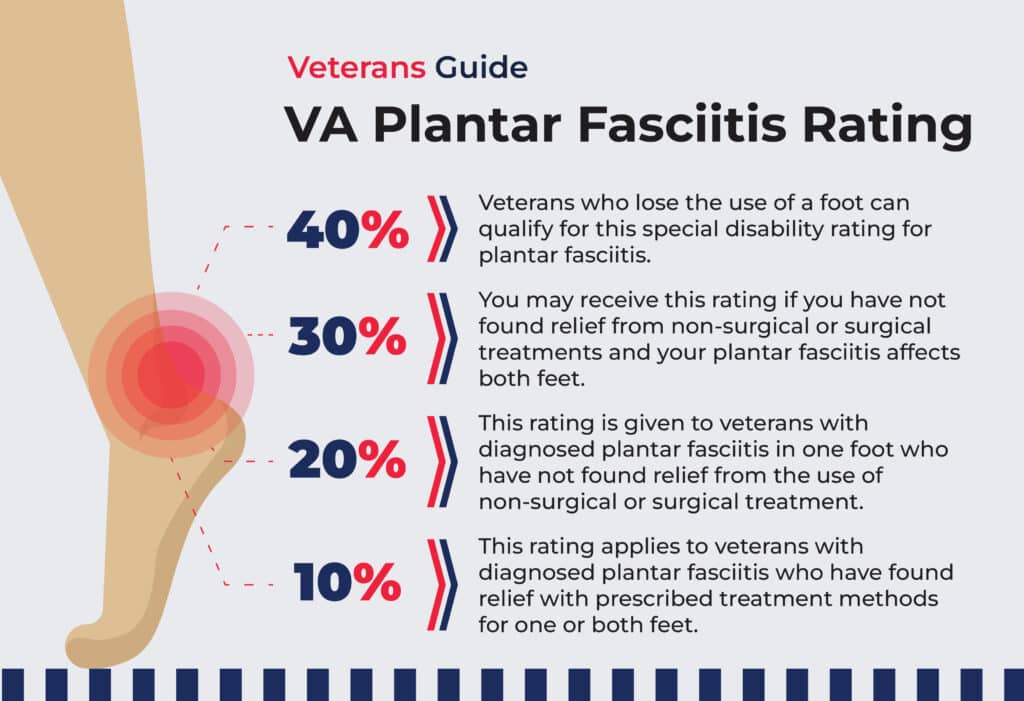Home » VA Disability Conditions List » VA Disability Rating for Plantar Fasciitis
VA Disability Rating for Plantar Fasciitis
If you’ve been diagnosed with foot pain, you may be eligible to receive a plantar fasciitis VA rating. Your diagnosis might be related to other military-connected disabilities, such as a foot or knee injury. In that case, you can apply for a secondary rating for plantar fasciitis and receive monthly compensation. For more information on plantar fasciitis and how to qualify for VA disability, contact Veterans Guide.
- Veterans with plantar fasciitis can qualify for a VA disability rating, which varies based on the condition’s severity and impact on both feet, with a maximum rating of 40%.
- Plantar fasciitis is considered for VA compensation when it’s linked to military service, requiring a formal diagnosis and evidence of service connection, potentially as a secondary condition to other service-related injuries.
- Treatment options for plantar fasciitis include non-surgical methods like orthotics and weight management, with surgical interventions considered in more severe cases.
Plantar fasciitis, also known as runner’s heel, is a painful condition that causes inflammation of the fascia—a type of connective tissue—in your heel. Plantar fasciitis afflicts the band of fascia that runs across the bottom of your foot that connects your heel bone to your toes. Plantar fasciitis pain is typically more pronounced first thing in the morning and then improves throughout the day. Symptoms include sharp, stabbing pain in the heel and tenderness in the bottom of the foot that worsens with walking or prolonged periods of standing.
If you’re a veteran who has experienced the symptoms of plantar fasciitis, see your doctor for a diagnosis. You may be eligible to apply to the U.S. Department of Veteran Affairs for a VA rating for your plantar fasciitis. You are at risk for developing plantar fasciitis if you:
- Are over age 40
- Are female
- Have flat feet or high arches
- Are overweight
- Have an atypical walk pattern, such as inward pronation
- Engage in activities that place stress on the heel and attached tissue of the foot, such as long-distance running
- Work in an occupation that requires you to stand or walk on hard or uneven surfaces for a long period
- Wear shoes with inadequate arch or heel support, or high heels
Untreated plantar fasciitis may result in knee, hip, and back pain as you adjust your walking gait to avoid discomfort in your feet.
Veterans and Plantar Fasciitis
Veterans can receive service-connected disability pay for plantar fasciitis if they show the condition is related to their military service. Standing, walking, and carrying heavy loads across hard and uneven terrain during active duty puts pressure on the tissues of the feet. As a result, military service is a frequent cause of foot pain and injury.
How Does the VA Rate Plantar Fasciitis?
Plantar fasciitis is included on the VA’s musculoskeletal rating schedule under conditions affecting the foot. To be eligible for compensation, you will need to make an appointment and obtain a diagnosis from a podiatrist. Podiatrists specialize in treating conditions of the feet. Your doctor will conduct a physical examination and order X-rays to look for evidence of plantar fasciitis in your feet, such as calcified heel spurs.
They can discuss non-surgical treatment options with you, including weight loss, orthopedic shoes or orthotic inserts, and surgery. Your doctor may also provide medical documentation as evidence that another military-connected event, injury, or illness caused your plantar fasciitis.
What Rating Can the VA Give Plantar Fasciitis?
The maximum disability rating a veteran can receive for plantar fasciitis is 40 percent. You can receive a rating of 10 percent, 20 percent, 30 percent, or 40 percent, depending on the severity of your symptoms and whether one or both feet are affected.
- 40 percent: Veterans who lose the use of a foot can qualify for this special disability rating for plantar fasciitis.
- 30 percent: You may receive this rating if you have not found relief from non-surgical or surgical treatments and your plantar fasciitis affects both feet.
- 20 percent: This rating is given to veterans with diagnosed plantar fasciitis in one foot who have not found relief from the use of non-surgical or surgical treatment.
- 10 percent: This rating applies to veterans with diagnosed plantar fasciitis who have found relief with prescribed treatment methods for one or both feet.
If surgery has been recommended, but the veteran is not eligible for surgery due to some other condition, the VA will evaluate the condition under the 20 percent or 30 percent criteria, whichever is applicable.

TDIU and Plantar Fasciitis
Total Disability based on Individual Unemployability (TDIU) is available to veterans who do not have a combined VA disability rating of 100 percent but are unable to work due to a service-connected disability. The program provides additional compensation to eligible veterans. Veterans must show they cannot find or maintain employment because of their disability to receive TDIU benefits.
In order to qualify for TDIU, you need a combined VA disability rating of 60 percent or higher. Since the highest rating you can receive for plantar fasciitis is 40 percent, you would not be eligible for TDIU compensation for this condition alone.
Plantar Fasciitis as a Secondary Disability
Plantar fasciitis can be tied to other military-connected medical conditions, including existing knee, hip, or back pain, flatfeet, or trauma to the feet. Veterans who show that their plantar fasciitis was caused by a previously diagnosed service-connected condition or worsened from military service can apply for a secondary disability rating.
What Is a Secondary Disability Rating?
If you developed plantar fasciitis after you got out of the military, you can apply for a secondary disability with the VA to increase your VA disability rating. To qualify for a secondary disability rating for plantar fasciitis, you would need to prove that:
- You have a current diagnosis of plantar fasciitis
- Your plantar fasciitis is connected to another military-connected disability or was worsened due to your military service
- You have a primary service-connected disability
How To Obtain VA Disability Compensation for Plantar Fasciitis?
To receive VA disability compensation for plantar fasciitis, you must prove that the condition is tied to or was worsened by your military service and not simply caused by age or genetic predisposition. Since that can be difficult to prove, getting the VA to assign a secondary disability rating for plantar fasciitis can be challenging.
Before you file a VA disability claim, document your plantar fasciitis symptoms, date of diagnosis, and any treatment you undergo to provide evidence of your disability so that your claim is rated correctly. You will also need to provide the following information to the VA:
- A copy of your plantar fasciitis diagnosis and diagnosis date
- Evidence of military-connected trauma that caused injury leading to plantar fasciitis
- A medical nexus letter from your doctor that states your military service caused or worsened your plantar fasciitis
How Can I Apply for VA Disability Compensation for Plantar Fasciitis?
You can file a VA disability compensation claim online. If you are filing an initial claim for disability, the VA will look at your medical records and require you to complete a VA physical examination.
If this is a secondary service-connected claim, you will need to submit evidence of the new disability and link your plantar fasciitis to the primary condition for which you are already receiving compensation. This typically requires medical records or a letter from your doctor supporting this connection.
Will I Need to Undergo an Exam?
The VA may request additional information to make a rating decision on your plantar fasciitis claim. In that case, you may need to see a VA physician to have a compensation and pension (C&P) exam performed. During the examination, be sure to explain how your plantar fasciitis is restricting your ability to live your life.
Increasing your VA disability rating may seem daunting or time-consuming. However, the effort can pay off if you receive more compensation. If you have more questions about how to file for a VA disability rating for plantar fasciitis, contact Veterans Guide.
Client Reviews
 ANN WILLIAMS
ANN WILLIAMS  SHELLY DONNETT'E
SHELLY DONNETT'E Want to Increase Your VA Rating?







